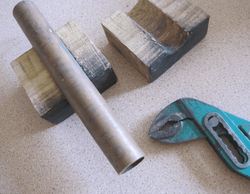I've always re-used copper fittings mainly because I can. The only big problem with doing so is that it can be hard to get the inside surfaces clean. The residual solder is hard to get out and it can be difficult or impossible to reuse the fitting until it's removed. Over the years I've tried different approaches with varying degrees of success--and usually burned fingers in any event. This hasn't stopped me from reusing fittings, but it has slowed me down and led to some less than admirable language.
This past weekend I stumbled across a really good solution to the fitting cleaning problem, in the form of braided stove door gasket. Because you can put a torch on it without it melting or burning, you can simply side the gasket rope into the fitting, heat it until the solder melts, then pull the rope through the fitting to clean out the molten solder.
Works like a charm. You get a fitting that's clean as a whistle every time. It's still important to clean off the external surfaces near the joint, but that can be easily done with steel wool or plumber's sandpaper. Using a vise makes everything a lot easier.
This past weekend I stumbled across a really good solution to the fitting cleaning problem, in the form of braided stove door gasket. Because you can put a torch on it without it melting or burning, you can simply side the gasket rope into the fitting, heat it until the solder melts, then pull the rope through the fitting to clean out the molten solder.
Works like a charm. You get a fitting that's clean as a whistle every time. It's still important to clean off the external surfaces near the joint, but that can be easily done with steel wool or plumber's sandpaper. Using a vise makes everything a lot easier.


 than ever. I don't mean to undermine your thread.... It's just how I've done it.
than ever. I don't mean to undermine your thread.... It's just how I've done it.
 !
!